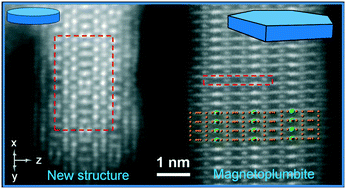A new polymorph of strontium hexaferrite stabilized at the nanoscale†
Abstract
During wet-chemical synthesis, metastable polymorphs frequently nucleate before the stable phase due to a lower nucleation barrier. These metastable polymorphs stabilized at the nanoscale represent some of the technologically most important nanomaterials, e.g., photocatalytic anatase and magnetic maghemite nanoparticles. However, such nanomaterials are not restricted to simple oxides. Here, we present a new polymorph of hexagonal strontium ferrite, i.e., hexaferrite, stabilized in the form of small discoid nanoplatelets. Under hydrothermal conditions the strontium ferrite forms as a result of reactions between Sr and Fe hydroxides in the presence of a high concentration of hydroxyl ions at temperatures below 80 °C. Atomic-resolution scanning-transmission electron microscopy showed that the primary discoid nanoplatelets (2–5 nm thick and a few tens of nm wide) exhibit an incredibly complex crystalline structure with a very large hexagonal unit cell (a = 56.6 Å, c = 18.0 Å) and are weakly ferrimagnetic. With exaggerated growth above 160 °C, the discoid nanoplatelets having the new structure recrystallize to larger hexagonal nanoplatelets with an equilibrium magnetoplumbite structure. The discovery of a new hexaferrite polymorph demonstrates the immense potential of the stabilization of new metastable polymorphs of complex functional materials for the discovery of new nanomaterials.



 Please wait while we load your content...
Please wait while we load your content...